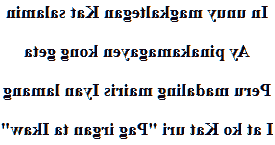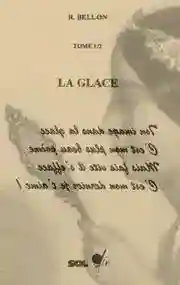Tagbanua love poem
Salamin
In unuy magkaltegan Kat salamin
Ay pinakamagayen kong geta
Peru madaling mairis Iyan lamang
I at ko Kat uri "Pag irgan ta Ikaw"

Traditional Tagbanwa script
ᝰᝮᝫᝲ
ᝡ ᝢᝨᝳ ᝫᝣᝦᝲᝤ ᝣ ᝰᝮᝫᝲ
ᝠ ᝩᝲᝨᝣᝫᝤᝬᝲ ᝣᝳ ᝤᝲᝦ
ᝩᝲᝮᝳ ᝫᝧᝮᝲ ᝫᝡᝮᝲ ᝡᝬ ᝮᝫ
ᝡ ᝠ ᝣᝳ ᝣ ᝢᝮᝲ ᝩ ᝡᝤ ᝦ ᝡᝣ
Modern Baybayin script
ᝰᝮᝫᝲᝨᝲᝳ
ᝡᝨᝲᝳ ᝢᝨᝳᝬᝲᝳ ᝫᝤᝲᝳᝣᝮᝲᝳᝦᝲᝤᝨᝲᝳ ᝣᝦᝲᝳ ᝰᝮᝫᝲᝨᝲᝳ
ᝠᝬᝲᝳ ᝩᝲᝨᝣᝫᝤᝬᝲᝨᝲᝳ ᝣᝳᝥᝳᝲ ᝤᝲᝦ
ᝩᝲᝮᝳ ᝫᝧᝮᝲᝥᝲᝳ ᝫᝡᝮᝲᝰᝲᝳ ᝡᝬᝨᝲᝳ ᝮᝫᝥᝲᝳ
ᝡ ᝠᝦᝲᝳ ᝣᝳ ᝣᝦᝲᝳ ᝢᝮᝲ ᝩᝤᝲᝳ ᝡᝮᝲᝳᝤᝨᝲᝳ ᝦ ᝡᝣᝯᝲᝳ
An other translation
Salamin
Yan akeng rupa sikayan it salamin
I"piyaka magayen, temed.
Basta mabilisan ta'mag kailang naga,
Yan pinaka kiya'pusan "maal ko"

→ French poem ←
Tagbanwa language
Tagbanua love poem (Aborlan Tagbanwa, Apurawnon, Tagbanwa), in an Austronesian language, from the Greater Central Philippine language branch.
Aborlan Tagbanwa, the language of the Tagbanwa, who live in the Aborlan region, in the central region of the island of Palawan in the Philippines, is spoken by approximately 15,000 people.
The other Tagbanwa languages are Calamian Tagbanwa and Central Tagbanwa, with which Aborlan is not mutually intelligible.
Usually, in addition to the language of their ancestors, the Tagbanua speak Tagalog, Palawano, and other languages of the region as Cuyonon.
Although the Philippine government has passed a law for the rights of indigenous peoples: to recognize them, To protect and promote their rights, Tagbanua and the two other Tagbanwa languages are gradually abandoned by younger people in favor of Tagalog and Cuyonon, and they are actually in great danger.
The Tagbanua
The Tagbanua are indigenous people of the Philippines. Their presence has been documented for over 20,000 years.
They live in the center of the island of Palawan, between the east and west coasts.
Hunting, fishing, livestock, farming, and some crafts, cultivation, and gathering are their daily lives.
The National Commission for the Indigenous Peoples recognizes the possession of their ancestral domains, lands, and coasts, with the right to manage and extract their resources.